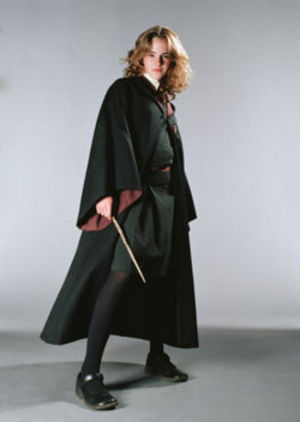The most popular children’s series in history offers readers a variety of things; interesting characters, fantastic settings and events, humor, drama, action, and an overall memorable and effective story. With the prominence of strong, courageous female characters, J.K. Rowling has essentially laid down groundwork for parents wishing to teach their children about the importance of feminism and equality.
Fans of the series (whether it’s the books, movies, or both) will quickly note the significance of Hermione Granger, one of Harry Potter’s best friends beside Ron Weasley. Hermione is introduced in the first book, Harry Potter and the Sorcerer’s Stone, as a “know-it-all[1] fanatically obsessed with rules and proper spell-casting.
Her knowledge is grating at first to her schoolmates, who also seem resentful of her skills, but her know-how comes in handy when she, Harry, and Ron face danger. She is able to bind Neville Longbottom after he attempts to stop them from leaving the school and she rescues Ron from the Devil’s Snare.[2] As the series continues, her intellect and skill prove to be crucial assets to Harry’s quests, and she also becomes an advocate for house elves, who are generally looked down on in wizarding society.[3]
While Hermione is the most popular female figure in the Harry Potter series, she is not alone. Hogwarts employs many female professors such as Minerva McGonagall, Sybill Trelawney, and Pomona Sprout. There is also Molly Weasley, a witch housewife who actively takes in Harry as a member of her family.
With such an array of foremost women characters, the series has taken criticism for portraying women in stereotypical roles. Natasha Whitton wrote a study on these portrayals and noted that Harry’s yearning for a closeness to his long-deceased mother, which is an understandable desire for any child in that circumstance, but she notes “that his idealization becomes one based on solipsistic yearning for her to be like him”[4] after he sees that they have the same eyes.
It’s curious that Whitton doesn’t also note that this discovery of their shared physical characteristic seems to stem from a desire to find a tangible connection to his mother and not from a latent mysogynistic viewpoint in a lonely eleven year old boy. Whitton goes on to describe the women characters in the series as “doting fools, overweight loud-mouths, simpering girls, crazy witches and old women”[5], first citing Ginny Weasley’s eagerness to see the famous boy wizard. Whitton fails to include the fact that in the first book, Ginny is approximately ten years old and therefore her behavior is understandable for young women of that age.
Whitton then critiques the portrayals of the professors of Hogwarts in the first book, admitting that “Snape and some of the other male professors are portrayed in an equally unflattering light, but there is always Dumbledore and Hagrid for Harry to look up to.”[6] Hagrid doesn’t become a professor until the third book, however, and Dumbledore does seem to be an almost saintly figure until the last book in the series, in which his past and his personal mistakes are revealed.
Whitton’s criticism of Hermione Granger is the most direct. Her interaction with Harry before he goes to face Voldemort seems to upset Whitton the most. After Hermione encourages Harry by telling him that he’s a great wizard, he modestly informs her that he thinks she’s a better one. She replies that bravery and friendship are more important than cleverness and knowledge from books.
“I found it hard to swallow this sudden transformation of a studious, earnest young lady into a simpering sycophant,” Whitton wrote. What she failed to notice is that Hermione delivered the essential message of the book, and of the series; bravery and solidarity is what ultimately saved Harry and his friends from death in the final book. Also, Rowling conveys the message that while studiousness is rewarding, love and bravery are – and should be – rewarded over all. It’s also alarming that Hermione’s encouragement of Harry and her earnest concern for her friend’s safety is seen as “simpering” rather than sincere and kindhearted.
The gender backlash against Harry Potter has gotten its own backlash, with critics arguing that the supposed sexism in the series is misread. On Salon.com, Chris Gregory admits that men seem to dominate the wizard world, but in Potter’s universe, [7]
Freelance author Christine Schoefer has argued that Rowling’s series has perpetuated stereotypical roles with female characters seen as irritating tag-alongs and giggling idolators. In her article on Salon.com, she poses two curious questions:
“Is our longing for a magical world so deep, our hunger to be surprised and amazed so intense, our gratitude for a well-told story so great that we are willing to abdicate our critical judgment? Or are the stereotypes in the story integral to our fascination — do we feel comforted by a world in which conventional roles are firmly in place?”[8]
What Schoefer does not note is that children stories often do dabble in stereotypes, whether they are positive or negative; mischievous elves, innocent and naïve children and young women, oblivious and ignorant men of power (mostly kings or fathers), wicked stepparents, evil witches, double-crossing wisemen and cruel siblings. These stereotypes can be utilized as a tool to properly teach children about how popular belief can overshadow fact. It is also key to note that stories written for children often are unable to go into depth of character because of the audience’s inability to yet grasp concepts of psychology.
Also, as the story of Harry Potter unfolds, the strengths and weaknesses of all the characters, namely Harry himself, are clearly outlined as the danger of Voldemort increases, pasts are revealed, and the children become young adults.
While Harry is undoubtedly the hero of the story, he often makes mistakes and at times, his temper bests him and he is often subdued by his friends, Ron and Hermione. The feminist argument against the Harry Potter series seems to be one left to judgement by the reader, and as Gregory writes in her article, the argument seems more centered on Rowling’s choice for a main character:
In the end, it seems that Rowlings is guilty less of creating stereotypical female characters than of writing a book centering on a boy, one of whose friends happens to be a girl. But who says women must write about female characters?”[9]
[1] “Hermione Granger.” Wikipedia, the free encyclopedia. URL: (http://en.wikipedia.org/wiki/Hermione_Granger)
[2] Ibid.
[3] “Society for the Promotion of Elfish Welfare (S.P.E.W.)” Wikipedia, the free encyclopedia. URL: (http://en.wikipedia.org/wiki/S.P.E.W.)
[4] Natasha Whitton, “”Me! Books! And Cleverness!:” Stereotypical Portrayals in the Harry Potter Series.” Women Writers. URL: (http://www.womenwriters.net/summer04/reviews/HarryPotter.htm)
[5] Ibid.
[6] Ibid.
[7] Chris Gregory, “Hands off Harry Potter!: Have Critics of J.K. Rowling’s Books Even Read Them?” Salon.com, March 1, 2000. URL: (http://archive.salon.com/books/feature/2000/03/03/harry_potter/)
[8] Schoefer, Christine. “Harry Potter’s Girl Trouble: The World of Everyone’s
favorite Kid Wizard is a Place where Boys come First.” Salon.com, October 30, 2000. URL: (http://www.salonmag.com/books/feature/2000/01/13/potter/)
[9]Chris Gregory, “Hands off Harry Potter!: Have Critics of J.K. Rowling’s Books Even Read Them?” Salon.com, March 1, 2000. URL: (http://archive.salon.com/books/feature/2000/03/03/harry_potter/)




